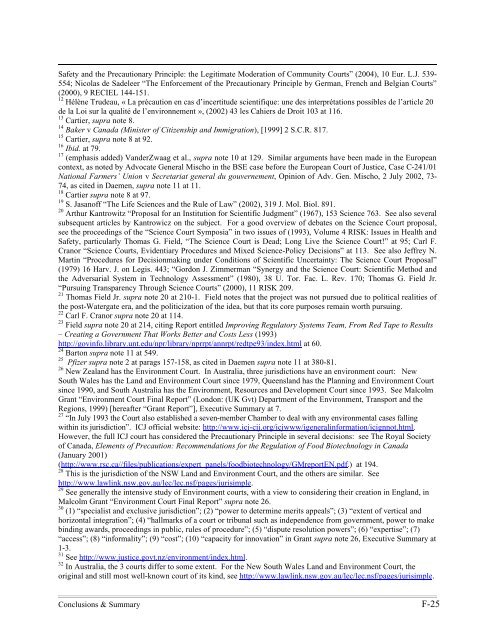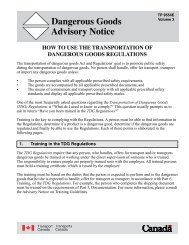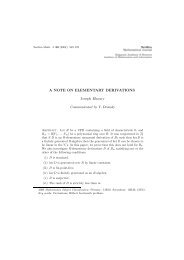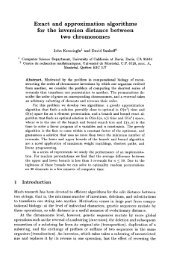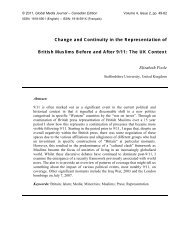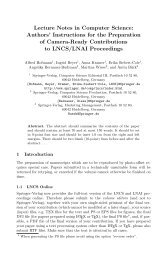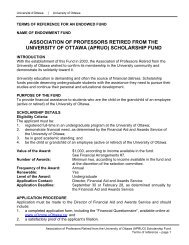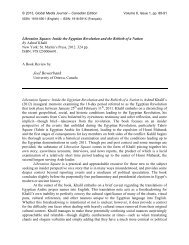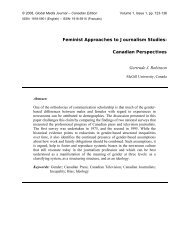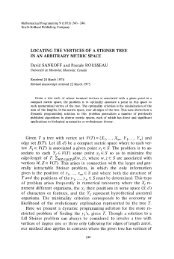PRACTICING PRECAUTION and ADAPTIVE MANAGEMENT ...
PRACTICING PRECAUTION and ADAPTIVE MANAGEMENT ...
PRACTICING PRECAUTION and ADAPTIVE MANAGEMENT ...
- No tags were found...
Create successful ePaper yourself
Turn your PDF publications into a flip-book with our unique Google optimized e-Paper software.
Safety <strong>and</strong> the Precautionary Principle: the Legitimate Moderation of Community Courts” (2004), 10 Eur. L.J. 539-554; Nicolas de Sadeleer “The Enforcement of the Precautionary Principle by German, French <strong>and</strong> Belgian Courts”(2000), 9 RECIEL 144-151.12 Hélène Trudeau, « La précaution en cas d’incertitude scientifique: une des interprétations possibles de l’article 20de la Loi sur la qualité de l’environnement », (2002) 43 les Cahiers de Droit 103 at 116.13 Cartier, supra note 8.14 Baker v Canada (Minister of Citizenship <strong>and</strong> Immigration), [1999] 2 S.C.R. 817.15 Cartier, supra note 8 at 92.16 Ibid. at 79.17 (emphasis added) V<strong>and</strong>erZwaag et al., supra note 10 at 129. Similar arguments have been made in the Europeancontext, as noted by Advocate General Mischo in the BSE case before the European Court of Justice, Case C-241/01National Farmers’ Union v Secretariat general du gouvernement, Opinion of Adv. Gen. Mischo, 2 July 2002, 73-74, as cited in Daemen, supra note 11 at 11.18 Cartier supra note 8 at 97.19 S. Jasanoff “The Life Sciences <strong>and</strong> the Rule of Law” (2002), 319 J. Mol. Biol. 891.20 Arthur Kantrowitz “Proposal for an Institution for Scientific Judgment” (1967), 153 Science 763. See also severalsubsequent articles by Kantrowicz on the subject. For a good overview of debates on the Science Court proposal,see the proceedings of the “Science Court Symposia” in two issues of (1993), Volume 4 RISK: Issues in Health <strong>and</strong>Safety, particularly Thomas G. Field, “The Science Court is Dead; Long Live the Science Court!” at 95; Carl F.Cranor “Science Courts, Evidentiary Procedures <strong>and</strong> Mixed Science-Policy Decisions” at 113. See also Jeffrey N.Martin “Procedures for Decisionmaking under Conditions of Scientific Uncertainty: The Science Court Proposal”(1979) 16 Harv. J. on Legis. 443; “Gordon J. Zimmerman “Synergy <strong>and</strong> the Science Court: Scientific Method <strong>and</strong>the Adversarial System in Technology Assessment” (1980), 38 U. Tor. Fac. L. Rev. 170; Thomas G. Field Jr.“Pursuing Transparency Through Science Courts” (2000), 11 RISK 209.21 Thomas Field Jr. supra note 20 at 210-1. Field notes that the project was not pursued due to political realities ofthe post-Watergate era, <strong>and</strong> the politicization of the idea, but that its core purposes remain worth pursuing.22 Carl F. Cranor supra note 20 at 114.23 Field supra note 20 at 214, citing Report entitled Improving Regulatory Systems Team, From Red Tape to Results– Creating a Government That Works Better <strong>and</strong> Costs Less (1993)http://govinfo.library.unt.edu/npr/library/nprrpt/annrpt/redtpe93/index.html at 60.24 Barton supra note 11 at 549.25 Pfizer supra note 2 at parags 157-158, as cited in Daemen supra note 11 at 380-81.26 New Zeal<strong>and</strong> has the Environment Court. In Australia, three jurisdictions have an environment court: NewSouth Wales has the L<strong>and</strong> <strong>and</strong> Environment Court since 1979, Queensl<strong>and</strong> has the Planning <strong>and</strong> Environment Courtsince 1990, <strong>and</strong> South Australia has the Environment, Resources <strong>and</strong> Development Court since 1993. See MalcolmGrant “Environment Court Final Report” (London: (UK Gvt) Department of the Environment, Transport <strong>and</strong> theRegions, 1999) [hereafter “Grant Report”], Executive Summary at 7.27 “In July 1993 the Court also established a seven-member Chamber to deal with any environmental cases fallingwithin its jurisdiction”. ICJ official website: http://www.icj-cij.org/icjwww/igeneralinformation/icjgnnot.html.However, the full ICJ court has considered the Precautionary Principle in several decisions: see The Royal Societyof Canada, Elements of Precaution: Recommendations for the Regulation of Food Biotechnology in Canada(January 2001)(http://www.rsc.ca//files/publications/expert_panels/foodbiotechnology/GMreportEN.pdf.) at 194.28 This is the jurisdiction of the NSW L<strong>and</strong> <strong>and</strong> Environment Court, <strong>and</strong> the others are similar. Seehttp://www.lawlink.nsw.gov.au/lec/lec.nsf/pages/jurisimple.29 See generally the intensive study of Environment courts, with a view to considering their creation in Engl<strong>and</strong>, inMalcolm Grant “Environment Court Final Report” supra note 26.30 (1) “specialist <strong>and</strong> exclusive jurisdiction”; (2) “power to determine merits appeals”; (3) “extent of vertical <strong>and</strong>horizontal integration”; (4) “hallmarks of a court or tribunal such as independence from government, power to makebinding awards, proceedings in public, rules of procedure”; (5) “dispute resolution powers”; (6) “expertise”; (7)“access”; (8) “informality”; (9) “cost”; (10) “capacity for innovation” in Grant supra note 26, Executive Summary at1-3.31 See http://www.justice.govt.nz/environment/index.html.32 In Australia, the 3 courts differ to some extent. For the New South Wales L<strong>and</strong> <strong>and</strong> Environment Court, theoriginal <strong>and</strong> still most well-known court of its kind, see http://www.lawlink.nsw.gov.au/lec/lec.nsf/pages/jurisimple.Conclusions & Summary F-25


